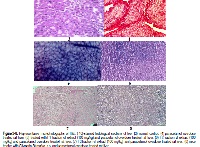Evaluation of hepatoprotectve activity and isolation of 2-(3, 4-dihydroxy phenyl)-7-hydroxy-3-(2-hydroxy ethoxy) 4-H-chromen-4one from column fractions of leaves of the extract of Crataeva magna.
Keywords:
Crataeva magna, hepatopreventive effect, column fractions, flavonoid compoundAbstract
Nature is only source of hepatoprotective drugs in modern medicine to prevent and treat drug-induced liver damage. The alcoholic extract of fresh leaves of the plant Crataeva magna, previously reported for its hepatoprotective activity was fractionated into three parts to chemically identify the most potent bioactive fraction. The current study was designed to evaluate the hepatoprotective activity, isolation and characterization property of effective column fractions of the leaves of the plant Crataeva magna. The hepatopreventive effect of the column fractions (F1, F2 and F3) of the leaves of the plant were evaluated by measuring the levels of serum liver damage marker enzyme such as alanine transaminase, aspartate transaminase, alkaline phosphatase, total and direct bilurubin. As per the result, since the F3 fraction of the extract showing out the significant reduction in the elevated serum level which can be compared with the standard drug silymarin therefore, phytochemical investigation of the F3 fractions led to the identify the structure of the flavonoid compound which was established by spectroscopic methods (UV, IR, 1H NMR, 13C NMR and EI-MS) as 2-( 3, 4-Dihydroxy Phenyl )-7-Hydroxy-3-( 2-Hydroxy Ethoxy) 4-H-Chromen-4one.
References
Robak J, Gryglewski RJ. Bioactivity of flavonoids. Pol J Pharmacol 1996; 48:555-564.
Tsimogiannis D.I, Oreopoulou V. The contribution of flavonoid C-ring on the DPPH free radical scavenging efficiency. A kinetic approach for the 3´, 4´-hydroxy substituted members. Innov. Food Sci. Emerg. Technol. 2006; 7: 140-146.
Shahidi F. Flavonoids as Antioxidants; Natural Antioxidants. Chemistry, Health Effects and Practical Applications. AOCS Press: Champaign Illinois.; 1997. p. 174-94.
Birt DF, Hendrich S, Wang W. Dietary agents in cancer prevention: flavonoids and so flavonoids. Pharmacol Therapeut. 2001; 90:157-177.
Bors W, Michel C. Chemistry of the antioxidant effect of polyphenols. Ann NY Acad Sci.; 2002. p. 957:57-69.
Manach C, Scalbert A, Morand C, Remesy C, Jimenez L. Polyphenols: food sources and bioavailability. Am J Clin Nutrients. 2004; 79:727-747.
Khairullin VR, Gerchikov YA, Denisova SB. Comparative study of the antioxidant properties of selected flavonols and flavanones. Kinet Catal. 2010; 15(2):219-224
Baskar R, Meenalakshmi M, Varalakshmi P. Effect of lupeol isolated from Crataeva nurvala stem bark against free radical-induced toxicity in experimental urolithiasis. Fitoterapia. 1996; 67:121–125.
Sunitha S, Nagaraj M, Varalakshmi P. Hepatoprotective effect of lupeol and lupeol linoleate on tissue antioxidant defense system in cadmium-induced hepatotoxicity in rats. Fitoterapia. 2001; 72:516–523.
Sudharsan PT, Mythili Y, Selvakumar E, Varalakshmi P. Lupeol and its ester ameliorate the cyclophosphamide provoked cardiac lysosomal damage studied in rat. Mol Cell Biochem. 2006; 282: 23–29.
Geetha T, Varalakshmi P Anti-inflammatory activity of lupeol and lupeol linoleate in rats. J Ethnopharmacol. 2001; 76:77–80.
Latha RM, Lenin M, Rasool M, Varalakshmi P. A novel derivative pentacyclic triterpene and ω 3 fatty acid [Lupeol–EPA] in relation to lysosomal enzymes glycoproteins and collagen in adjuvant induced arthritis in rats. Prostaglandins Leukot Essent Fatty Acids. 2001; 64(2):81–85.
Mhaskar KS, Blatter F, Caius JF (Eds.). In: Kirtikar and Basu’s Illustrated Indian Medicinal Plants: Their usage in Ayurveda and Unani medicines. Delhi: Sri Satguru Publications.; 2000. p. 254-59.
Mekap SK, Mishra S, Sahoo S, Panda PK. Antiurolithiatic activity of Crataeva magna Lour. bark. Indian J Nat Prod Resour. 2011; 2(1): 28-33.
CSIR Crataeva. In: Wealth of India. Council for Scientific and Industrial Research, New Delhi.; 1987. p. 366.
Pattanaik S, Si SC, Rout SS, Nayak SS. Evaluation of Hepatoprotective and Lipid Peroxidation activity of the leaves of the plant Crataeva magna Buch Ham (Family Capparidaceae). Der Pharmacia Lettre. 2013; 5 (2):333-337.
Groote D J, Steenbergen VW. Paracetamol intoxication and N-acetylcysteine treatment. Acta Gastro-Enterologica Bélgica. 1995; 58: 326–334.
S. Pattanaik, S. C. Si, S. S. Nayak, Evaluation of free radical scavenging activity, wound healing activity and estimation of phenolic, flavonoid and proanthocyanidine contents of the plant “crateva magna” Asian Journal of Pharmaceutical and Clinical Research, 2012; 5 (Suppl 3), 168-171.
Mello PD and Rana M. Hepatoprotective activity of Psidium guajava extract and its phospholipid complex in paracetamol induced hepatic damage in rats. International Journal of Phytomedicines. 2010; 2: 85-93.
Yoshigurki M, Toshihara H & Shoji A, High molecular weight protein aggregates formed in the liver of paracetamol treated rats, J Pharm Pharmacol. 1992; 44: 932.
H. U. Bergmeyer, G. N Bowes, M. Horder, D. W. Moss, Provisional recommendations on IFCC methods for the measurement of catalytic concentrations of enzymes. Part 2. IFCC method for aspartate aminotransferase. Clin Chim Acta. 1976; 70:19–29.
N. W. Tietz, A. D. Rinker, L. M. Shaw, IFCC methods for the measurement of catalytic concentration of enzymes. Part 5. IFCC method for alkaline phosphatase (orthophosphoricmonoester phosphohydrolase, alkaline optimum, EC 3. 1. 3. 1). J Clin Chem Clin Biochem. 1983; 21:731–748.
Kappas A, Simionatto CS, Drummond GS, Sassa S, Anderson KE. The liver excretes large amounts of heme into bile when heme oxygenase is inhibited competitively by Sn-protoporphyrin. Proc Natl Acad Sci U S A. 1985; 82:896 –900.
Slater TF. Biochemical studies on liver injury. In Biochemical Mechanism of liver Injury. London: Academic Press.; 1965. p. 144.
Plaa GL, Hewitt WR. Quantitative evaluation of indices of hepatotoxicity. In toxicology of the liver. New York: Ravan Press.; 1992. p. 103-20.



